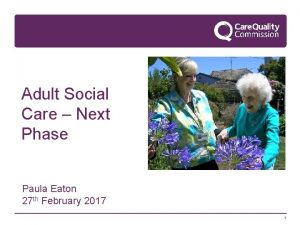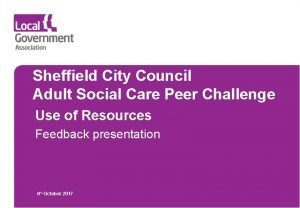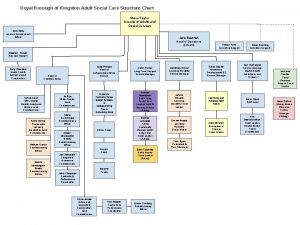Adult Social Care Next Phase Paula Eaton 27
















- Slides: 16

Adult Social Care – Next Phase Paula Eaton 27 th February 2017 1

Assessment Framework changes: Evolution, not revolution Same structure: Key Questions, KLOEs, Characteristics of Ratings Strengthen Simplify • Based on learning & and changes in the sector • Aligning the questions we ask the different sectors & services • • Not ‘raising the bar’ for providers • Enable providers to show they are developing and adapting Promote idea of a single shared view of quality • A simpler process to reduce regulatory burden on providers 2

Key changes – important themes • Caring strengthened to include resources, time and support for staff to work with individuals in a compassionate way • • More open KLOE questions (Do & Are? to How? ) Information sharing, governance and data security Technology (risks and opportunities) Medicines KLOE strengthened EDHR strengthened Even bigger focus on personalisation Support to live healthier lives 3

Key changes Assessment Framework Some key changes for Adult Social Care: • Safe – support for people when behaviour challenges: Moved from Effective • Effective – processes to ensure no discrimination: Moved from Safe • Effective – organisations working together: Moved from Responsive • Effective – staff working together across organisations Moved from Responsive • Responsive – supporting people at the end of their life Moved from Caring 4

Five New KLOEs Key Changes for ASC • S 1 How do systems, processes and practices safeguard people from abuse? • S 6 Are lessons learned and improvements made when things go wrong? • E 1 Are people’s needs and choices assessed and care, treatment and support delivered in line with current legislation, standards and evidence-based guidance to achieve effective outcomes? • W 2 Does the governance framework ensure that responsibilities are clear and that quality performance, risks and regulatory requirements are understood and managed? • W 3 How are the people who use the service, the public and staff engaged and involved? 5

Eleven Changed KLOEs (1) Key Changes for ASC • S 2 How are risks to people assessed and their safety monitored and • • • managed so they are supported to stay safe and their freedom is respected? S 4 How does the provider ensure the proper and safe use of medicines? E 2 How does the service make sure that staff have the skills, knowledge and experience to deliver effective care and support? E 5 How are people supported to have healthier lives, have access to healthcare services and receive ongoing healthcare support? E 6 How are people's individual needs met by the adaptation, design and decoration of premises? C 1 How does the service ensure that people are treated with kindness, respect, and compassion, and that they are given emotional support when needed? 6

Eleven Changed KLOEs (2) Key Changes for ASC • C 2 How does the service support people to express their views and be actively involved in making decisions about their care, support and treatment as far as possible? • C 3 How is people's privacy, dignity and independence respected and promoted? • R 2 How are people’s concerns and complaints listened and responded to and used to improve the quality of care? • W 1 Is there a clear vision and credible strategy to deliver high-quality care and support, and promote a positive culture that is personcentred, open, inclusive and empowering, which achieves good outcomes for people? • W 4 How does the service continuously learn, improve, innovate, and ensure sustainability? 7

Aggregation principles • The five key questions are all equally important and should be weighted equally when aggregating • All ratings will be treated equally for the purposes of aggregating unless one of the other principles below applies • At least two of the key questions being “outstanding” with the remainder of the ratings being “good” aggregates to an overall rating of “outstanding” • At least two of the key questions being “requires improvement” aggregates to an overall rating of “requires improvement” • If one of the key question ratings is “Inadequate”, the overall aggregated rating cannot be higher than “requires improvement” • At least two of the key questions being “inadequate” aggregates the overall rating to “inadequate” 8

Well-led limiters The four principles below show events and circumstances that mean that the well-led question can never be rated better than “requires improvement” • • The location has a condition of registration that it must have a registered manager but it does not have one, and satisfactory steps have not been taken to recruit one within a reasonable timescale The location has any other condition of registration that is not being met without good reason Statutory notifications were not submitted in relation to relevant events at a location without good reason The provider has not returned the PIR or contact information, where requested by CQC, or supplied the information in another format as agreed in advance. Providers should have this information readily available to them through the internal systems they are required to have to monitor and improve the quality of their service. 9

Rating and reporting on locations with a breach - ASC • A provider with a breach cannot be rated as Good. • Providers rated as good are meeting the standards set out in the regulations and display the characteristics of good care (i. e. to be rated good means more than just meeting the standards set out in the regulations) [CQC enforcement policy p 9] • Inspectors should use their judgement about whether an incident constitutes a breach of regulations in the normal way, taking into account the impact on people, the history of the service regarding any previous incidents it has had and how it responded to them. Where an incident has a low impact, inspectors should consider the proportionate action to take - this may include making a recommendation - and reflect this in their report. • Our ratings must be proportionate to all of the available evidence and the specific facts and circumstances 10

Repeat Requires Improvement • Ongoing monitoring informs inspection planning • Letter stating subsequent RI may be considered breach of Regulation 17 • Enforcement action • Consider improvement action plan • Meet with provider, registered manager and commissioners 11

Focused Inspections • Based on risk • Always look at Well Led and other domains where there has been a breach or risk identified. • 6 month limit for overall rating change abolished • Expand to comprehensive inspection where necessary • Next comprehensive inspection only brought forward where rating worsens after focused inspection 12

For a good service to be rated outstanding . . there additional key characteristics that make the service exceptional and distinctive 13

Themes from Well-Led – Outstanding • People who use services, relatives and staff • speak highly of the service • Effective monitoring and quality assurance • 75% of services had a registered manager in post consistently • Open culture – people who use services/ staff/ relatives shared views and issues • Good leadership extends beyond the manager and those values inspire staff • A can do, will do attitude – staff dedication • Strong links with local community • Safe care actively promoted – effective oversight of care and staff communication

Top tips for achieving an outstanding rating • Set out your ambition to be outstanding – It has to start at the top • Involve staff, residents, their relatives and other health professionals in developing strategies to help you achieve your ambition • Determine where you are now and identify the gaps you need to plug • Can you easily identify the outstanding features in your home? Will your staff, residents, other health professionals support your view? • What makes a difference between good and outstanding is often how the service pays attention to detail – simple things done well that have a significant impact on the people using the service • Think about how you will sustain high quality performance • Work hard on ‘your’ ability to demonstrate the impact your intervention is having on people. Ask yourself whether people, their relatives, staff and other professionals will corroboration your assessment of your quality when asked.

Thank you www. cqc. org. uk enquiries@cqc. org. uk @Care. Quality. Comm Paula Eaton, Inspection Manager 16
 X.next = x.next.next
X.next = x.next.next Paula eaton
Paula eaton Adult social care sheffield
Adult social care sheffield Adult social care kingston
Adult social care kingston Levels of care primary secondary tertiary quaternary
Levels of care primary secondary tertiary quaternary Health and social care values unit 2
Health and social care values unit 2 Normal phase vs reverse phase chromatography
Normal phase vs reverse phase chromatography Hplc reverse phase vs normal phase
Hplc reverse phase vs normal phase Mobile phase and stationary phase
Mobile phase and stationary phase Chromatography means
Chromatography means Normal phase vs reverse phase chromatography
Normal phase vs reverse phase chromatography Line vs phase voltage
Line vs phase voltage Adsorption chromatography
Adsorption chromatography In a ∆-connected source feeding a y-connected load
In a ∆-connected source feeding a y-connected load Csce 441
Csce 441 Apa itu social thinking
Apa itu social thinking Social thinking social influence social relations
Social thinking social influence social relations































